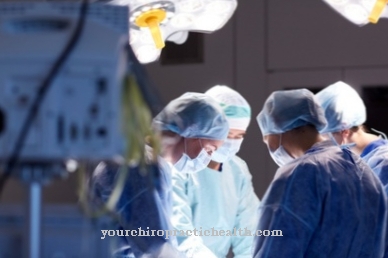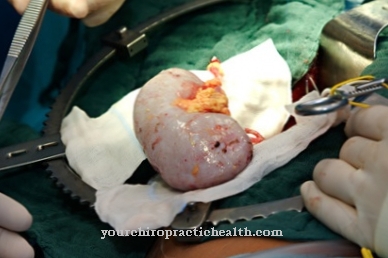As Osteosynthesis is a surgical procedure for treating bone fractures. The individual broken bones are brought together again with different tools such as nails, screws, plates and wires.
What is osteosynthesis?

The medical term osteosynthesis is translated in German with bone connection. It is the generic term for various surgical interventions to bring broken bones back together.
By using various connecting aids, the broken bones are stabilized again so that they can grow together again as intended by the human anatomy. The aim of osteosynthesis is to bring bones back together in their original form. The fracture site is stabilized and the function of the affected bone is restored until it heals.
Function, effect & goals
There are different procedures:
- Intramedullary nail osteosynthesis
- Plate fixation
- Screw fixation
- Kirschner wire fixation (preferably in children)
- Tension band osteosynthesis
- External fixator
- Dynamic hip screw for a fracture near the femur. Not every broken bone has to be treated with an osteosynthesis.
Doctors perform osteosynthesis for the following clinical pictures:
- Fractures of the joints
- open fractures with injury to soft tissues and skin
- Fractures that affect nerves and blood vessels
- Broken bones in the leg
- Multiple fractures (multiple broken bones)
- in patients with multiple trauma due to life-threatening multiple injuries
- in osteoporosis and old age
- in patients who need to be mobilized again quickly (e.g. athletes)
The human bones consist of compacts (firm bark) and cancellous bone (soft inner core). The medullary canal is located in the large bones where the bone marrow lies. The bones are wrapped in a periosteum. With age, the bone marrow is replaced by fatty tissue. Before the medical professionals operate on the fracture, they must return the affected bones to their correct and original position. In the case of less severe bone fractures, this reduction can be carried out without surgery.
The doctor brings the bones back into place by skillfully positioning them, then the break is fixed with a strong bandage so that the bones do not slip again. In this case, the fracture can heal without surgery. With intramedullary nail osteosynthesis, the surgeon opens the medullary cavity of the affected bone using an awl or wire. A guide wire is passed through this channel and pushed into the bone marrow cavity using a reamer. Through this process, the medullary canal is widened and provided with a long nail, which acts as an inner splint in the broken bone. X-ray controls ensure the correct position of the nail. If necessary, the nail is locked with a transverse bolt (locking nail) to prevent it from shifting in the medullary canal.
With plate fixation, the bone fracture is exposed and provided with a plate that is anatomically matched to the bone and fastened with screws in such a way that it connects the fragments with one another. Screw osteosynthesis works with lag screws and cancellous screws. After opening the bone, the lag screw slides through a hole in the cortex. At the opposite end, a much smaller hole is drilled and a thread inserted, which is connected to the lag screw. This is how the broken bone is held together. The cancellous screw is shaped like a long shaft. Here, too, the screw is fastened by means of a thread through drill holes behind the fragment. The Kirschner wire fixation is suitable for correcting fractures in smaller bones such as the fingers or toes.
The Kirschner wire is inserted through the bony cortex deep into the cancellous bone of the bone, with the upper end remaining on the outside in order to pull it out again after the fracture has healed. This method does not stabilize sufficiently, so the application of a plaster cast or a splint is necessary to withstand loads. With the tension band osteosynthesis, the individual bone fragments are connected by spike wires. They run perpendicular and parallel through the fracture gap. The outer ends are crossed and provided with a soft wire loop (clerage). The opposite book office is provided with a channel through which the wire loop is looped. The surgeon stretches these tightly in order to hold the book pieces tightly together and to convert the tensile forces that actually pull the individual broken bones apart into compressive forces. The bone fragments are pushed together.
External fixator fixes the bone fracture using an external device. The fracture is stabilized by pins on both sides of the bone. These are attached to the left and right by making small cuts through the skin and connected with a metal strut that provides the necessary stability. The dynamic hip screw is used for femoral neck fractures. A screw is inserted into the part of the hip joint that is closest to the hip joint by means of a guide wire. The screw is screwed into the femoral head with a short, thick thread.
A metal plate is screwed into the upper, outer area of the thigh bone. The threadless end of the screw shaft slides through a tube, so that the patient's body weight deflects the load pressure and the fracture is pushed together.
Risks, side effects & dangers
After performing the osteosynthesis, the surgeon sutures the muscles in the first step, followed by the layers of connective tissue and the skin. Osteosynthesis procedures are routine interventions, but occasionally complications cannot be ruled out.
In rare cases, tendon adhesions, joint stiffening, curvature of cartilage, muscles, tendons and nerves, compartment syndrome, lack of or insufficient fracture healing (pseudarthrosis), bone necrosis (death of individual pieces of bone) and infections of the bone and periosteum can occur. General operational risks are bleeding, blood clots, nerve injuries, local infections, incidents of anesthesia, allergic reactions to individual substances and scarring. As soon as the postoperative situation allows, osteosynthesis patients should move again as quickly as possible; excessive rest is the wrong approach and can lead to complications such as joint stiffening.
Physiotherapy is the ideal way to return to a normal stressful situation after a hospital stay. The osteosynthesis material such as screws, wires and plates are removed from arms and shoulders in a period of 6 to 24 months for broken bones and after 12 to 24 months for fractures in the leg area.












.jpg)



.jpg)










.jpg)
